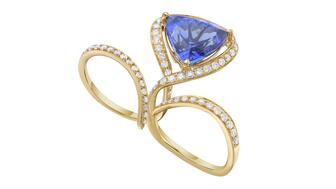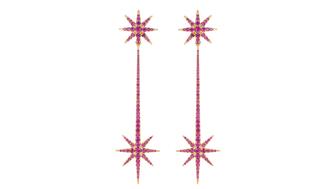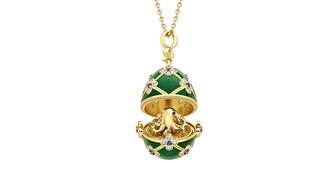Set in a Tiffany & Co. necklace, it sold for $4.2 million, the highest price and price per carat paid for a Paraíba tourmaline at auction.
E-Commerce Site Memo Lets Consumers Try Before They Buy
Memo is bridging the gap between online and brick-and-mortar shopping through an innovative retail model.

Rochester, N.Y.--Debra LaBudde has decades of experience advising companies on new and unexploited markets. So when she founded her own company last year, she focused on what she contends is just such an opportunity: fine jewelry.
“I think there’s kind of an untapped market, believe it or not, for fine jewelry,” LaBudde explained. “(I saw) an interesting opportunity in the marketplace that, in my mind, hasn’t been well served, and that ultimately could create a larger market.”
Memo is LaBudde’s answer to what she feels is missing in single-channel retail models—the tactile, personal access to jewelry that is found in a brick-and-mortar experience, coupled with the convenience and accessibility of online shopping.
Memo’s “complimentary home try-on” period bridges this gap.
When clients order a piece on ExperienceMemo.com, they receive it via free two-day shipping and have three days to try it on and consider the item before being charged. If dissatisfied, they can return it within that timeframe with the free return shipping Memo provides.
All of Memo’s inventory is kept in stock and, in case of returns, Memo reabsorbs that product.

“It’s interesting what happens in the home (when you try the jewelry on) because I’ve gone through the experience independently and it’s pretty special,” said LaBudde. “Obviously, we have security in place, but there’s a fair amount of trust that goes into it too and the kind of reciprocal respect that we get with clients is pretty amazing.”
To insure themselves against theft, Memo collects credit card information prior to shipping the jewelry to consumers--just as in a traditional online purchase--to be charged when the three-day try-on period is over. They also place a hold on the card prior to sending product to verify against fraudulent credit card orders.
LaBudde is aiming to give the Memo e-commerce experience the same personal and connective quality that one might find shopping in a well-curated, independent boutique.
In addition to the at-home try on period, LeBudde is achieving this through site content. Customers can learn about the designers whom Memo stocks through artfully produced video interviews on the site (five of the 12 designers are currently featured), as well as detailed descriptions of particular products in the words of their creators.
“Our platform is so rich from a visual standpoint,” LaBudde said. “I think we can tell the story of collections and designers in a strong way.”
“When I was traveling less, I was still trying to find new pieces and new designers but I found it was difficult to have that same intimate experience online,” said the Rochester, New York-based businesswoman.
Making that high-touch experience accessible regardless of location was LaBudde’s initial inspiration for Memo.
Each aspect of Memo’s non-traditional retail process is the result of months of consumer research, identifying what consumers liked and disliked about both online and brick-and-mortar shopping.
LaBudde found that like herself, shoppers enjoyed the accessibility of online shopping but found the experience lacking certain elements of the store purchase they enjoyed.
“We’re in a world today where people are used to the internet and the convenience that that provides,” LaBudde explained, “but with convenience you sometimes give up other aspects--the relationship that is formed if you meet a designer directly. This is our solution for tying that together.”
She continued: “When we created Memo we took a fair amount of time to not try to force a model or technology on the (jewelry) industry but to really look at the industry and hear from both clients and designers what was needed.”
So far, LaBudde said that her customers, who are comprised mainly of self-purchasing women, are embracing the Memo experience, and Memo is succeeding in making e-commerce feel human.
This is exemplified by the requests LaBudde has been getting for custom pieces from the designers she stocks, a service she says most of them are happy to provide.
Memo doesn’t disclose its financials, but LaBudde said that while the company is in its infancy, her focus is on building it to its full potential. She’s started hosting pop-up events where clients can meet designers face-to-face and has plans to carry more designers on the site.
“When I talk about growing a market, I truly believe in women buying for themselves and the evolution of designer jewelry and designer names around a product,” said LaBudde. “I think there’s a greater opportunity to reach a new customer that really doesn’t know this world.”
The Latest

The jeweler’s “Deep Freeze” display showcases its iconic jewelry designs frozen in a vintage icebox.

Take luxury gifting to new heights this holiday season with the jeweler’s showstopping 12-carat sphene ring.

How Jewelers of America’s 20 Under 40 are leading to ensure a brighter future for the jewelry industry.

This year's theme is “Unveiling the Depths of the Ocean.”


In its annual report, Pinterest noted an increase in searches for brooches, heirloom jewelry, and ‘80s luxury.

Starting Jan. 1, customers can request the service for opal, peridot, and demantoid garnet.

Roseco’s 704-page catalog showcases new lab-grown diamonds, findings, tools & more—available in print or interactive digital editions.

The 111-year-old retailer celebrated the opening of its new location in Salem, New Hampshire, which is its third store in the state.

The new catalog features its most popular chains as well as new styles.

The filmmaker’s personal F.P. Journe “FFC” prototype was the star of Phillips’ recent record-setting watch auction in New York.

The new location in the Design District pays homage to Miami’s Art Deco heritage and its connection to the ocean.

Inflations, tariffs, and politics—including the government shutdown—were among consumers’ top concerns last month.

“Longtime favorite” presenters, as well as first-time speakers, will lead talks and workshops at the annual event in Tucson next year.

Silas Smith of Meridian Metalworks won the challenge with his pendant that blends Australian and American landscapes.

The sale of the 31.68-carat, sunset-hued stone was part of Sotheby’s first series of events and auctions in Abu Dhabi.

Most customers who walk into your store this month have made up their minds. Your job is to validate their choice, Emmanuel Raheb writes.

The collection features characters and motifs from Ukrainian folklore, including an enchanted mirror and a magic egg.

The pavilion will be part of the 2026 JA New York Spring show, scheduled for March 15 to 17.

Kadet, a 1994 National Jeweler Retailer Hall of Fame inductee, helped grow the family-owned retailer in the Chicago area and beyond.

Don’t let those with December birthdays feel blue. Help them celebrate their month with blue zircon, turquoise, and tanzanite.

The new pink sapphire version of the piece dances with its wearer in the brand’s “Icons After Dark” holiday campaign.

A choice that’s generated a lot of commentary, Pantone says “Cloud Dancer” marks a fresh start and encourages relaxation and creativity.

The manufacturer’s holiday campaign features a gift guide filled with trending designs and jewelry that can be personalized.

The man was charged with theft, accused of ingesting the necklace while in a jewelry store in Auckland, New Zealand.

The Florida independent expanded its store from 8,000 to 14,000 square feet, fulfilling the vision of its late co-founder, Jim Dunn.

Sponsored by De Beers Group




























